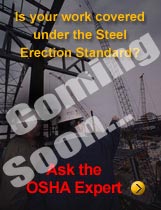Site Preparation
1926.752 Site layout, site-specific erection plan and construction sequence
 Proper communication between the controlling contractor and the steel erector prior to the beginning of the steel erection operation is essential to employee safety. Many accidents involving collapse could have been averted had adequate pre-erection communication and planning occurred. The following requirements for site preparation, including site layout, pre-planning of overhead hoisting operations, and
(in some cases) site-specific erection plans, have been made to ensure safety during the initial stages of steel erection. Proper communication between the controlling contractor and the steel erector prior to the beginning of the steel erection operation is essential to employee safety. Many accidents involving collapse could have been averted had adequate pre-erection communication and planning occurred. The following requirements for site preparation, including site layout, pre-planning of overhead hoisting operations, and
(in some cases) site-specific erection plans, have been made to ensure safety during the initial stages of steel erection.
-
The controlling contractor must provide written notification to the steel erector ensuring
that [1926.752(a)]:
-
Concrete in footings, piers, and walls has been cured to a level that will provide adequate strength
to support any forces imposed during steel erection [1926.752(a)(1)].
Tip: The criteria for adequate strength depends on the
results of required American Society for Testing and Materials standard test
methods.
-
Anchor bolt repairs, replacements and modifications were done with the approval of the project Structural Engineer of Record
(SER) [1926.752(a)(2)
and 1926.755(b)(1)].
-
A steel erection contractor may not erect steel without the above written notification [1926.752(b)].
|
-
In order for the steel erector to perform necessary operations in a safe manner, the controlling contractor must provide and maintain [1926.752(c)]:
-
Access roads into and through the site that are adequate for safe delivery and movement of:
-
derricks,
-
cranes,
-
trucks,
-
other necessary equipment,
- the material to be erected
[1926.752(c)(1)];
-
 Means and methods for pedestrian and vehicular control. [1926.752(c)(1)] Means and methods for pedestrian and vehicular control. [1926.752(c)(1)]
- Adequate space for the safe storage of materials and the safe operation of the erector's equipment, which is
- firm,
- properly graded,
- drained,
- readily accessible to the work [1926.752(c)(2)].
Exception: This provision does not apply to roads outside of the construction site.
|
-
All hoisting operations in steel erection must be pre-planned to ensure
that [1926.752(d)]:
-
Employees are not working directly below suspended loads, except for [1926.753(d)(1)]:
-
Where employees must work under the load, the materials being hoisted are:
|
-
Employers may elect, because of conditions specific to the worksite, to develop alternate means of providing the employee protection required in 1926.753(c)(5), 1926.757(a)(4) or 1926.757(e)(4). If a site-specific erection plan is used, it must:
-
be developed by a qualified person, and
-
be available at the work site [1926.752(e)].
Components of a site-specific erection plan [Non-mandatory Appendix A]
A site-specific erection plan is developed during one or more pre-construction conferences and site inspections involving the erector, the controlling contractor, and others such as the project engineer and the fabricator. In this process, the following elements are considered:
-
The sequence of erection activity, developed in coordination with the controlling contractor, including the following:

-
Material deliveries;
-
Material staging and storage; and
-
Coordination with other trades and construction activities.
-
A description of the crane and derrick selection and placement procedures, including the following:
-
Site preparation;
-
Path for overhead loads; and
-
Critical lifts, including rigging supplies and equipment.
-
A description of steel erection activities and procedures, including the following:
-
Stability considerations requiring temporary bracing and guying;
-
Erection bridging terminus point;
-
Notifications regarding repair, replacement and modifications of anchor rods (anchor bolts);
-
Columns and beams (including joists and purlins);
-
Connections;
-
Decking; and
-
Ornamental and miscellaneous iron.
-
A description of the fall protection procedures that will be used to comply with 1926.760.
-
A description of the falling object protection procedures that will be used to comply with 1926.759.
-
A description of the special procedures required for hazardous non-routine tasks.
-
A certification for each employee who has received training for performing steel erection operations as required by 1926.761.
-
A list of the qualified and competent persons.
-
A description of the procedures that will be utilized in the event of rescue or emergency response.
In addition, the plan should include identification of the site and project, and be signed and dated by the qualified
person(s) responsible for its preparation and modification.
|
|
|
|
|
